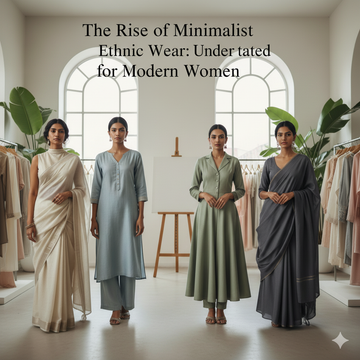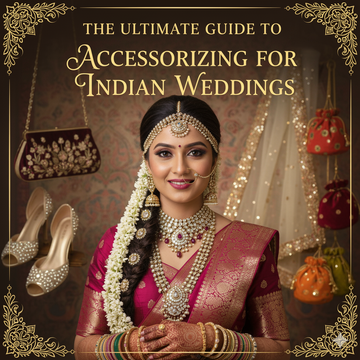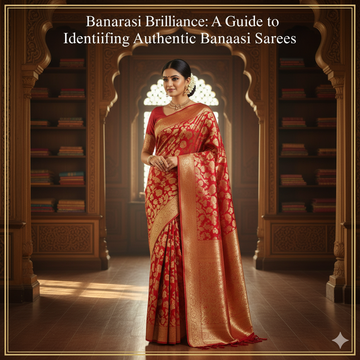The Rise of Minimalist Ethnic Wear: Understated Elegance for Modern Women
by Joelpaes . on Oct 01, 2025

A single shade of ivory. A whisper of embroidery on soft cotton. A silhouette that does not shout but lingers. That is the quiet revolution underway in women’s wardrobes where less is not loss, but grace redefined.
For years, Indian clothing was often associated with opulence, heavy zari, layered silks, ornate lehengas. While these still hold their charm, modern women are increasingly seeking garments that balance heritage with restraint. What has emerged is a movement toward minimalist ethnic wear, a style that reflects both rootedness and refinement. It is not a rejection of tradition, but a soft recalibration of it.

From Festive Extravagance to Everyday Ease
Traditional attire was once reserved for weddings, festivals, and grand ceremonies. Yet as lifestyles have shifted, the demand for garments that can be worn beyond celebrations has grown. Enter the rise of everyday ethnic wear, clothing that carries cultural resonance yet works in professional, casual, and semi-formal settings.
This has led to a surge in elegant kurtis, breathable cotton sarees, and lightweight salwar sets that are versatile enough for the office, brunch with friends, or even travel. Women no longer want their sarees locked in cupboards waiting for Diwali. Instead, there is a revival. Saree returns, not as a costume for special occasions, but as a garment that blends into daily life.

Minimalist Saree: A Statement Without Noise
Nothing embodies this movement more than the minimalist saree. Stripped of heavy borders and ornate detailing, it speaks through fabric quality, drape, and subtle design. Linen sarees with muted tones, khadi with single-color borders, and organza in pastel shades have found loyal admirers.
The minimalist saree redefines sensuality and strength with no need for excess, just six yards of honesty. When paired with a plain blouse or even a shirt, it creates a dialogue between heritage and modernity. Its charm lies in the fact that it does not demand attention, yet it holds it.

Simple Ethnic Wear for a Modern Palette
The younger generation, especially urban professionals, gravitates toward simple ethnic wear that merges comfort with sophistication. Cotton kurtis with straight cuts, anarkalis in solid shades, or salwars paired with crisp dupattas, have replaced heavy embellishments with sharp tailoring and breathable fabrics.
This shift is not accidental. With global exposure, travel, and digital influences, women have developed a taste for minimal wardrobes. They admire Scandinavian clean lines, Japanese restraint, yet want them through the lens of Indian culture. Hence, understated Indian fashion, a blending of muted color palettes, clean silhouettes, and thoughtful craftsmanship, has carved its own niche.

Saree Returns: Not Nostalgia, But Renewal
There was a time when many predicted the saree’s decline in everyday life, especially as Western wear dominated workplaces. Yet the recent saree returns movement shows otherwise. Women across cities are draping sarees not as symbols of age or conservatism, but as expressions of identity.
Instagram is filled with young professionals wearing cotton or linen sarees to work. College students experiment with drapes and quirky blouses. Designers are offering ready-to-wear sarees for those who struggle with pleats. What emerges is a celebration of the saree as both comfort and statement, minimal, yet striking.

Understated Indian Fashion: A Quiet Counter to Noise
Fast fashion thrives on excess prints, sequins, and disposable trends. Against this, understated Indian fashion feels almost like a rebellion. It is clothing that asks women to breathe instead of perform. Instead of loud motifs, it offers earthy tones. Instead of glitter, it offers woven textures. Instead of fleeting novelty, it offers timelessness.
This approach also aligns with a broader cultural return to sustainability. Choosing a minimalist saree or elegant kurtis in handloom fabric is not only about aesthetics but about respecting the artisan and valuing durability over fleeting showiness. In this way, fashion becomes both personal expression and quiet activism.

Everyday Ethnic Wear as a Language of Comfort
There is also a psychological side to this trend. Clothing that feels natural, light, and breathable allows women to move freely without being weighed down. Everyday ethnic wear has therefore become a form of self-care garments that serve the body, rather than demand sacrifice for appearance.
Soft cottons, block prints, and uncluttered silhouettes enable women to wear ethnic garments not once in a blue moon, but as part of their daily rhythm. In this, style merges with comfort in ways that earlier generations did not always prioritize.

The Subtle Strength of Elegant Kurtis
Among all garments, the elegant kurtis stands out as the quiet star. Its versatility cannot be overstated; it pairs with jeans, palazzos, or churidars; it can be formal with dupattas or casual with sneakers. More importantly, it allows women to feel rooted while moving through contemporary spaces with ease.
The modern kurti is less about intricate embellishment and more about flow, fabric, and form. It is clothing that whispers instead of shouts, reflecting a woman’s personality without overwhelming it.
Minimalist ethnic wear is not just a fashion trend, it is a cultural response to modern lives that demand lightness, movement, and authenticity without losing heritage. It proves that elegance does not need ornament, and tradition does not need to be theatrical to survive.
In a world often dazzled by excess, the quiet folds of a minimalist saree, the clean lines of simple ethnic wear, or the grace of elegant kurtis remind us: beauty sometimes arrives dressed in silence.




